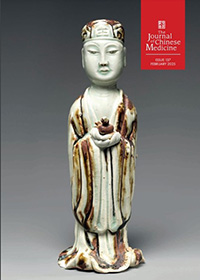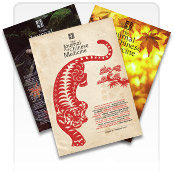We use cookies to make your experience better. To comply with the new e-Privacy directive, we need to ask for your consent to set the cookies. Learn more.
Latest Issue
Latest issue no. 137 - Feb 2025

Features & Articles in this issue
Editorial
Author: Daniel Maxwell
Interesting discussion on Facebook about the ‘negativity’ of acupuncturists towards biomedical drugs. Given that iatrogenic deaths have been rated as the fifth leading cause of death globally (https://tinyurl. com/2jmttupe) and prescription drugs are estimated to be third highest cause of death in the West (https:// tinyurl.com/yb6v5ysx) it is no surprise that feelings run high on the subject. Cue battle lines drawn on multiple fronts and talking acu-heads throwing out salvos in all directions...
Scalp Acupuncture for Treating the Face
Author: Michelle Gellis
This article is excerpted from the newly-published text Treating the Face: A Comprehensive Guide for Acupuncturists and Health Professionals by Michelle Gellis. It consolidates the material published by the author in previous issues of the Journal of Chinese Medicine, providing a pragmatic clinical introduction to scalp acupuncture - a clinically valuable modern method that can be used to support the treatment of a multitude of pathologies affecting the face.
‘Mr Evil Bone Water’: An Interview with Mark Brinson
Author: Mark Brinson & Daniel Maxwell
This article is an edited transcript of an interview with Mark Brinson, Chinese medicine physician and originator of Evil Bone Water, a product which has become beloved by many acupuncture practitioners across the USA and internationally for its clinical effectiveness.
A Case of Not Asthma
Author: Caroline Radice
Asthma is a serious and chronic respiratory disease that can impair quality of life significantly. Patients are typically managed through prescriptions of inhaled and oral medications and avoidance of triggers. However, if these standard treatments fail, how might a patient with breathing difficulty find relief? Traditional East Asian Medicine provides an alternative lens to diagnose and treat chronic respiratory distress that has not responded to biomedical treatment. This article presents the case of a patient who suffered from difficulty breathing for three years without resolution but was successfully treated with Chinese herbal medicine in just a few weeks.
Artificial Intelligence and Acupuncture: A Manifesto
Author: Vanessa Menéndez Covelo
This article explores the current applications of artificial intelligence (AI) to the practice of acupuncture, and attempts to foresee how this might change the way acupuncturists practise. Sample uses of a specialised acupuncture application of the large language model ChatGPT are given, in which brief handwritten notes are uploaded and diagnosis and treatment are provided by the ‘AI assistant’. The article concludes by considering the advantages and pitfalls presented to the acupuncture profession by AI.
Chinese Medical Perspectives on Longevity: Bridging Ancient and Modern Insights on Lifespan and Healthspan
Author: Christian Saint-Pierre & Julie Saint-Pierre
This article examines Chinese medical perspectives on longevity through the lens of jīng, the vital essence central to health and ageing, and connects these ancient insights with emerging biomedical research on interleukin-11 (IL-11). Jīng, a foundational concept in Chinese medicine, is viewed as the source of life’s vitality, governing growth, reproduction and the ageing process. Recent studies identify IL-11 as a biomolecular factor linked to age-related disease and degeneration, suggesting that elevated IL-11 contributes to senescence, fibrosis and chronic illness in mature adults. By correlating IL-11’s biological roles with the functions of jīng, this article proposes that managing IL-11 levels could enhance both healthspan and lifespan. Traditional Chinese health practices - such as dietary therapy, acupuncture, qìgōng, tàijíquán and botanical supplementation - are explored for their potential to inhibit IL-11 activity, thereby preserving jīng and mitigating age-related decline. The article ultimately advocates for an integrative model, in which modern biomedical findings on IL-11 enhance the practice of Chinese medicine to offer more comprehensive longevity strategies.
Clinical Use of Chai Gui Tang and Gui Zhi Fu Ling Wan in Treating Uterine Cysts and Myomas
Author: Jeffri Tay Kai Wen & Jane Faustina Halim
Uterine cysts and myomas, categorised as zheng jia (癥瘕) in TCM, are common gynaecological diseases. Although some are asymptomatic, some can cause serious complications such as ruptures, torsions or bleeding. In the presented case, a 60-year-old female arrived at the clinic complaining of persistent pelvic pain. Imaging initially showed a uterine cyst, and subsequently a myoma was found. The patient preferred Chinese herbal medicine over modern medical intervention. Professor Huang Huang’s Fang-Bing-Ren (Formula-Disease-Person) triangle diagnosis method was applied. Based on this method, Chai Gui Tang (a combination of Minor Bupleurum Decoction and Chinese Angelica and Peony Powder) and Gui Zhi Fu Ling Wan (Cinnamon Twig and Poria Pill) were selected for treating the patient. After a year of administration, both the myoma and uterine cyst had disappeared.
Anatomy of an 18th Century Materia Medica: The ‘Bǎizhǒng’ of Xú Dàchūn
Author: Tom Ehrman
The Shénnóng Běncǎojīng Bǎizhǒnglu (Records of a Hundred Items from the Divine Farmer’s Classic of Materia Medica), often later abbreviated to ‘Bǎizhǒng’, is among the shortest materia medica from the Qing dynasty, as well as one of the best known. Written by the famous Xú Dàchūn, it is notable for combining both the very old and the very new. While remaining faithful to the descriptions of herbs found in the very earliest běncǎo, it also attempts to explain their medicinal properties by examining the natural history of the herbs themselves, drawing analogies between features such as morphology, life-cycle, colour and so forth, and aspects of human anatomy and physiology. This is a characteristic of the later Qing dynasty běncǎo, which is not found in the earlier literature. It also contains much other commentary, often acerbic in nature, on topics familiar from the author’s other writings, such as the dangers of tonics, and the inadequacies of contemporary medical practice.
Liu Duzhou on Water Patterns: Part 2
Author: Eran Even
This article is a translation of the water pattern chapter from Professor Liu Duzhou’s concise yet powerful work, Shang Han Lun Lin Zheng Zhi Yao 伤 寒论临证指要 (Essential Points on Clinical Patterns in the Shang han lun). Part one of this article series was published in Journal of Chinese Medicine issue 135 (June 2024) and offered insights into the concept and emergence of water-related pathologies, as well as discussions on the primary presentations and treatment approaches. Part two discusses the patterns, diagnosis and treatment of water qi surging upwards.
A Case Report of Saam Acupuncture Quickly Ameliorating Autoimmune Pain
Author: George Mandler
Autoimmune diseases have become increasingly common over the past decade, yet there is limited research on how to prevent them. This case report examines a 43-year-old woman with coeliac disease who suddenly developed debilitating rheumatoid-like symptoms following a week of antibiotics for strep throat. She experienced severe pain for an entire month until she was treated solely with Saam acupuncture. After three treatments over a six-day period, her symptoms nearly fully resolved. This case report suggests that acupuncture could be a promising treatment as well as a preventative option for autoimmune diseases.
Book Reviews in this issue
-
A Catalog of Benevolent Items: Li Shizhen’s Compendium of Classical Chinese Knowledge by Paul Unschuld
-
The Jingfang Case Studies and Medical Treatises of Dr.Lou Shao-kun by Lou Shenshan (author), Will Ceurvels (translator)
-
Acupuncture Techniques: A Practical Manual by Tianjun Wang & Weixiang Wang (editors)
- Treating the Face: A Comprehensive Guide for Acupuncturists and Health Professionals byMichelle Gellis
-
Receive our beautifully printed journal on your doorstep three times a year in February, June and October and get 24/7 access to our vast digital archive of back content.

